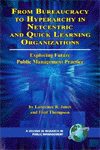
From Bureaucracy to Hyperarchy in Netcentric and Quick Learning Organizations
Exploring Future Public Management Practice
By:
Lawrence R. Jones, Naval Postgraduate School
Fred Thompson, Willamette University
A volume in the series: Research in Public Management. Editor(s): Lawrence R. Jones, Naval Postgraduate School.
Published 2007
This book focuses on the inherent contradiction between bureaucracy, hierarchy, and the vision inspired by the architecture of modern information technology of a more egalitarian culture in public organizations. We agree with Evans and Wurster and others who have argued that, in the future, knowledge-based productive relationships will be designed around fluid, teambased collaborative communities, either within organizations (i.e., deconstructed value chains), or in collaborative alliances such as those with "amorphous and permeable corporate boundaries characteristic of companies in the Silicon Valley" that is, deconstructed supply chains. In such relationships everyone can communicate richly with everyone else on the basis of shared standards and, like the Internet itself, these relationships will eliminate the need to channel information, thereby eliminating the trade-off between information bandwidth and connectivity. "The possibility (or the threat) of random access and information symmetry," they conclude, "will destroy all hierarchies, whether of logic or power."
CONTENTS
Preface and Acknowledments. Understanding Public Management as an International Academic Field. The Evolution of Public Management Reform Practice. Assessing Public Management Reform in an International Context: Performance Measurement, Managing for Results and Fiscal Devolution. Phases of Organizational Transformation and Restructuring. Changing Processes: What Works, What Does Not and Why? Implementing the Continuous Learning Cycle to Improve Strategic Planning and Organizational Productivity. Matching Institutional Structure to Strategic Planning and Positioning. Creating the Quick Learning Organization in Government. Moving From Bureaucracy to Hyperarchy and Netcentricity: Enabling the Quick Learning Organization Using IT and Modern Technology. References. Index.
-
Paperback978-1-59311-605-7
Web price: $45.04 (Reg. 52.99)
-
Hardcover978-1-59311-606-4
Web price: $80.74 (Reg. 94.99)
- eBook9781607525875

- BUS030000 - BUSINESS & ECONOMICS: Human Resources & Personnel Management
- BUS041000 - BUSINESS & ECONOMICS: Management
- EDU036000 - EDUCATION: Organizations & Institutions
-
 Arming America at War
A Model for Rapid Defense Acquisition in Time of War
Arming America at War
A Model for Rapid Defense Acquisition in Time of War
-
 Financing National Defense
Policy and Process
Financing National Defense
Policy and Process
-
 Governing Fables
Learning from Public Sector Narratives
Governing Fables
Learning from Public Sector Narratives
-
 Outcome-Oriented Public Management
A Responsibility-Based Approach to the New Public Management
Outcome-Oriented Public Management
A Responsibility-Based Approach to the New Public Management
-
 The Legacy of June Pallot
Public Sector Financial Management Reform
The Legacy of June Pallot
Public Sector Financial Management Reform
-
 Trust and Governance Institutions
Asian Experiences
Trust and Governance Institutions
Asian Experiences
-
 Why did Anticorruption Policy Fail?
A Study of Anticorruption Policy Implementation Failure in Indonesia
Why did Anticorruption Policy Fail?
A Study of Anticorruption Policy Implementation Failure in Indonesia

